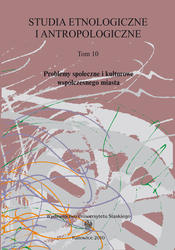

We create, animate and value space, marking it with a historical memory of events and filling it with artifacts. They constitute signs and symbols transmitted with the whole cultural heritage and tradition to next generations. A town dweller, as man of a traditional rural community, moves throughout his/her whole life between two types of space: a safe one (orbis interior) and an unknown, foreign, dangerous one (orbis exterior). The loss of place by an individual in a known and safe space causes willingness and need to find him/herself a place. The lack of ingrainment causes the inability of identification. The individual often feels alienated, deprived of his/her “own place” in the natural, historical, geographical, ethnic and cultural sense. The identification as such of Ciechanów town dwellers who came to Warszawa 30—40 years ago proves the lack of the sense of full identity with the cultural space of the capital. It is to a greater extent the identification with particular places in this space, e.g. with an Old Town, The Warsaw University, Warsaw University of Life Sciences, Wilanów or even The Palace of Culture and Science. A big part of the cultural space in Ciechanów was rejected, especially the one which lost its traditional image and because of Macdonaldisation became unremarkable (e.g. Marshal J. Piłsudski Square). The young generation of children of migrants from Ciechanów, brought up already in Warszawa, e.g. in the district of Ursynów, shows the sense of bond with the cultural town space, both the traditional, modern and Macdonald one. At the same time, they are more and more interested in places connected with the childhood of their grandparents and parents, as well as more and more often reveal the willingness to identify with the traditional cultural space of their ancestors.
Download files
Citation rules

Vol. 10 (2010)
Published:
 10.31261/SEIA
10.31261/SEIA